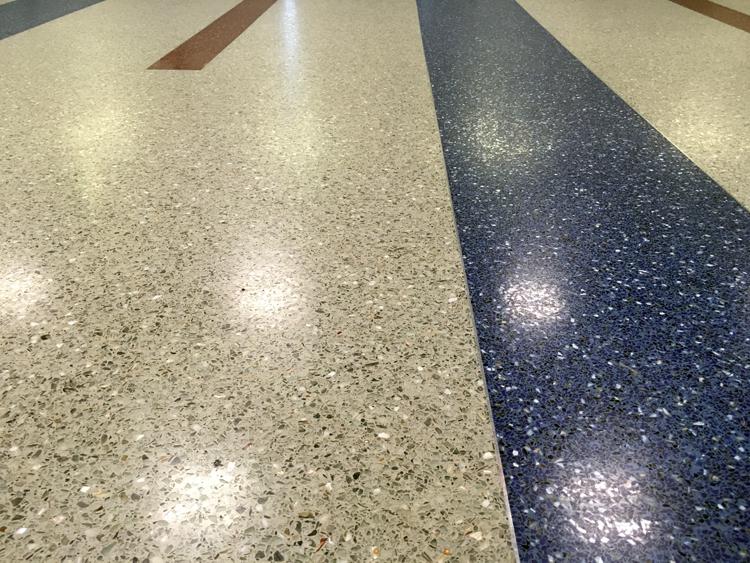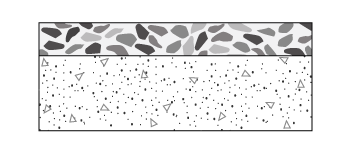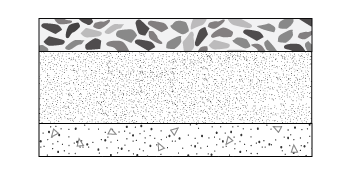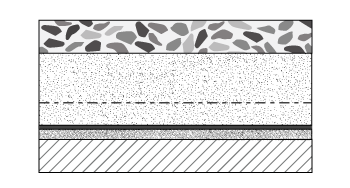Terrazzo is a solid flooring material made with chips of marble or other stone pieces set in a cementitious or resinous binder. After the terrazzo has cured, it is ground and polished to a shiny and durable finish.
The following image is a closeup shot of a terrazzo floor. Notice the zinc strip that separates the two different colors/mixes. The hot spots on the floor are from recessed down lights in the ceiling above.

Types of Terrazzo - Aesthetic Appearance
Standard Terrazzo is made from relatively small stone chips and is typically ground and polished.
Venetian Terrazzo is also ground and polished, however the stone chips are larger in size. The larger chips can also be infilled with smaller chips.
Rustic Terrazzo is a uniformly textured finish where the binder is recessed from the chips. To accomplish this, the surface is sprayed before the binder fully sets, which slightly exposes the stone chips.
Palladiana Terrazzo is more of a mosaic finish where very large chips (or slabs) of stone are set with the joints between slabs infilled with standard terrazzo.
There are a number of terrazzo systems that can be used. The diagrams below show the main types of systems. While the type of terrazzo is selected for its physical appearance, the terrazzo system is selected based on construction technique and the project conditions.
Thin-set Terrazzo

Thin-set Terrazzo is a 1/4" or 3/8" thick resinous topping that is directly applied over a sub-floor. Typically the sub-floor is concrete due to its stability; however, plywood floors may also be used if they are properly installed. Usually, the resin is epoxy, but polyacrylate is a common alternative. A flexible membrane may be installed between the sub-floor and the terrazzo finish so that minor cracks from the sub-floor are not translated to the finish flooring. Zinc, brass, or plastic dividers must be installed above any control joints in the sub-floor so that the terrazzo finish does not crack along the joints.
Thin-set Terrazzo Composition: (from bottom) Sub-floor (typically concrete or plywood) -- 1/4" or 3/8" terrazzo finish.
Monolithic Terrazzo

Monolithic Terrazzo is a 1/2" thick cementitious finish applied directly over a concrete sub-floor. When the sub-floor is very smooth a bonding agent is required so the terrazzo finish properly adheres to the concrete. The flatness and general quality of the concrete sub-floor is critical in preventing the terrazzo from cracking. Monolithic terrazzo is generally recommended for slab-on-grade applications because typical above grade floors are prone to deflecting, which causes cracks in the terrazzo finish. As with thin-set systems, monolithic systems require dividers at all control joints in the concrete sub-floor.
Monolithic Terrazzo Composition: (from bottom) Concrete slab -- Bonding agent when required -- 1/2" terrazzo finish.
Bonded Terrazzo

Bonded Terrazzo is a 1/2" thick cementitious finish applied over a sand-cement mortar underbed, which sits on a finished concrete slab. The advantage of a bonded terrazzo system over a monolithic system is that the sand-cement underbed easily accommodates variations in the concrete slab; therefore, the quality of the slab is not as critical. However, due to the thickness of the mortar underbed, a slab depression of 1.75" to 2.5" is required. Dividers are required at all control joints in the concrete slab. Bonded terrazzo systems are acceptable for use indoors and outdoors.
Bonded Terrazzo Composition: (from bottom) Rough-finished concrete slab -- Mortar underbed -- 1/2" terrazzo finish.
Sand Cushion Terrazzo

Sand Cushion Terrazzo is a 1/2" cementitious terrazzo finish that sits on a mesh reinforced mortar underbed, which is separated from the sub-floor by a isolation sheet. A sand cushion terrazzo floor is the ideal system for a floor where deflection or movement is anticipated. However, due to the thickness of the system a slab depression of 2.5" to 3" is required. Dividers at approximately 5'-0" on center are still required to help offset any expansion or contraction of the terrazzo finish. The isolation sheet and mesh reinforced mortar underbed will absorb most of the sub-floor imperfections so that they are not telegraphed to the finished terrazzo.
Sand Cushion Terrazzo Composition: (from bottom) Plywood or concrete sub-floor -- Thin layer of sand -- Isolation sheet -- Sand-cement underbed with mesh reinforcement -- 1/2" terrazzo finish.


